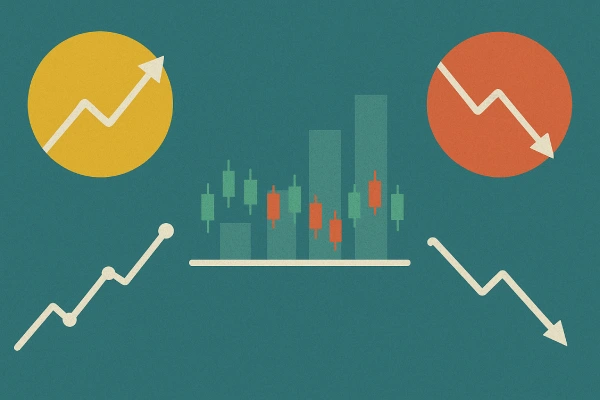Do you sometimes ask yourself why a perfect trade setup fails at times, while similar setups lead to solid profits at other times? You've followed your rules, used your indicators, and perhaps even waited for the perfect entry point. However, the market doesn't care, and in the end, it just didn't work on that occasion. If you are thinking that you can relate to this, you are not on your own! You are also likely missing one critical piece of the overall puzzle: the market environment you are trading in.
Evaluating market environments (some traders refer to them as conditions) is almost like analyzing the weather before you consider planning a trip. You would not pack sarongs, sunscreen, and shorts for a day at the beach if there were a storm blowing in—so why would you trade aggressively in a range-bound or choppy environment? In this article, I will break down what I mean by market environment analysis, why it is often overlooked, and how easy it becomes to master it, improving your overall decision-making, timing, and ultimately results. Let's get started.
What Is Market Environment?
The "market environment" is a way to describe the overall condition or behavior of the market at any given time. Typically, market conditions refer to some or all of the following:
Trend direction (Bullish, bearish, or sideways)
Volatility
Volume and Liquidity
Momentum and Sentiment
Economic context and macro events
By understanding the environment in which you are trading, traders can adapt their trading approach to the current market conditions, rather than forcing trades based on inflexible setups that may not align with the market's mood.

Why Traders Overlook Market Environment
Most traders, particularly beginner traders, spend too much time thinking about entry signals, indicators, and setups. These are important, but you must keep in mind that they don't occur in isolation. Even a good trade can fail due to a bad market environment.
Part of the problem is that market environment analysis is not always integrated into trader courses, and more often than not, in some beginner videos, it is left completely out. Market environment analysis is usually regarded as a "soft skill" that traders are expected to acquire through self-learning from experience. So when they have no experience, it is easily disregarded when determining if this might help because their 'market environment' may be impacting their trade analysis and ultimately their trading decisions.
Different Market Environments
To trade correctly and achieve success, you need to understand the market environment in which you are trading. Most market environments generally fall into three categories:
1. Trending Markets
This is where the market is clearly either trending up or trending down. The trend should be defined by higher highs and higher lows (uptrend) and/or lower highs and lower lows (downtrend). Trending markets work best for momentum strategies or trend following strategies.
Best strategies: cross over moving averages, breakout trading, pullback entries
2. Range-Bound (sideways) Markets
In these markets, prices oscillate, typically bouncing between support and resistance, and are not in any longer-term direction. If traders try to trend-trade in these markets, they can easily get chopped up.
Best strategies: mean reversion, support/resistance plays, oscillators (RSI, Stochastic)
3. Volatile or News-driven Markets
Markets can fall into chaos from time to time when dealing with significant economic news, major earnings reports, or geopolitical developments. Price action can experience rapid or sporadic movement patterns.

Best approach: decrease position size, don't over-trade, and wait for clarity.
Identifying the market environment doesn't have to be overly complicated! Here are some straightforward, actionable items to help identify your market environment:
✅1. Identify the Trend
Look for identifying characteristics on your charts, such as support and resistance levels, trendlines, moving averages (ex., 50 or 200 intervals), or price structure. Are we making higher highs? Lower lows?
✅ 2. Measure Volatility
Look at Average True Range (ATR), Bollinger Bands width measurement, or just the size of recent candles. A sudden expansion in range might mark a transition in the environment.
✅ 3. Look at Volume
Volume can help confirm the quality of a move. If the price is increasing with rising volume, it's likely a valid trend. Also, thin volume? The chances of this move continuing are very low.
✅ 4. Be Aware of context
Stay informed by understanding earnings reports, bank meetings, large news stories, and macroeconomic data. These create the sentiment and tone of the market.
Aligning Strategy To Environment
This is where the true power lies. When your trading strategy aligns with your trading environment, your odds of success are drastically improved.
🔹 Trend-following?
Then stay out of thick, choppy ranges and wait for clear direction.
🔹 If you're scalping or range trading, then stay away from trending markets, where you will likely get stopped out as the price does not revert to a mean.
Your environment tells you when to go aggressive and when to play defense. We all have figurative traffic lights in investing: green, yellow, and red, with green meaning go, red meaning stop, and yellow meaning cautious. Typical Errors Traders Commit
Even experienced traders can sometimes fall into the traps of:
1. Trading aggressively in low volatility markets;
2. Trying to catch tops/bottoms in strong trends;
3. Forcing trades in unclear/transitional markets;
4. Ignoring the macro context and newsflow.
Simply stepping back to read the mood of the market can help you sidestep many of these errors.

Adapting in Real-Time
Market conditions can change rapidly. A trending market when it opens can become range-bound by midday. The ability to quickly adapt is what separates consistently profitable traders from everyone else.
Make a habit of constantly reassessing the environment throughout the trading day or week. Leverage tools like:
Multi-timeframe analysis;
Market internals (e.g., advance-decline ratios);
Sentiment indicators (e.g., VIX, put/call ratios, etc.).
Markets are fluid and dynamic. Your trading plan should be fluid and dynamic, too.
Practical Example
Hypothesize that you identify a textbook bullish breakout in a stock, and initiate a trade, but it burns back quickly without follow-through. What happened?
Upon further reflection, you discover:
The market (e.g., S&P 500) was range bound;
The breakout move had low volume.
There was an important Fed announcement later that day.
All signs that the environment was not supportive. It wasn't the trade setup that was the problem; it was the context.
Finally, why does it matter?
Many traders become fixated on their entry and exit signals, missing the bigger picture. Taking time to assess the market environment adds context to positioning. It filters out bad trades, helps you maintain patience during market pullbacks, and leads to much better timing on your entries.
It is not about trading more; it is about trading smarter. When you adapt to the environment, you stop fighting the market and start flowing with it.
Key Takeaways
1. The market environment is the mood of the market (i.e., trending, ranging, volatile, or quiet);
2. Our edge increases when we adapt our strategy to the environment.
3. Use simple tools (trend lines, volume, volatility, and macro awareness);
4. Reassess market conditions regularly; don't get stuck in one mindset;
5. Your edge begins with your strategy, but it is further enhanced by your ability to know when to use it.
By adopting the habit of reading the environment of the markets before trading, you will limit (if not eliminate) avoidable losses, as well as build your confidence as a trader. And over time, that can make all the difference between breaking even and being consistently profitable.




